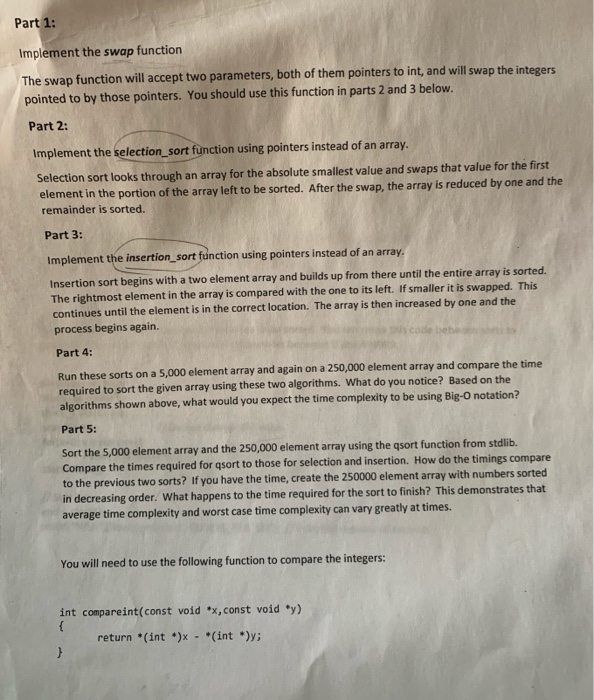please write a program with visaul studio code

Part 1: Implement the swap function The swap function will accept two parameters, both of them pointers to int, and will swap the integers pointed to by those pointers. You should use this function in parts 2 and 3 below. Part 2: Implement the selection_sort function using pointers instead of an array Selection sort looks through an array for the absolute smallest value and swaps that value for the first element in the portion of the array left to be sorted. After the swap, the array is reduced by one and the remainder is sorted. Part 3: Implement the insertion_sort function using pointers instead of an array. Insertion sort begins with a two element array and builds up from there until the entire array is sorted. The rightmost element in the array is compared with the one to its left. If smaller it is swapped. This continues until the element is in the correct location. The array is then increased by one and the process begins again. Part 4: Run these sorts on a 5,000 element array and again on a 250,000 element array and compare the time required to sort the given array using these two algorithms. What do you notice? Based on the algorithms shown above, what would you expect the time complexity to be using Big-O notation? Part 5: Sort the 5,000 element array and the 250,000 element array using the qsort function from stdlib. Compare the times required for sort to those for selection and insertion. How do the timings compare revious two sorts? If you have the time, create the 250000 element array with numbers sorted in decreasing order. What happens to the time required for the sort to finish? This demonstrates that average time complexity and worst case time complexity can vary greatly at times. You will need to use the following function to compare the integers: int compareint(const void *x,const void *y) return *(int *)x - *(int *); The syntax for Asort is: qsort(array, count, size, compare) The prototype uses the size_t type that we haven't discussed but can be replaced with integer values. It is: vold qsort(void base, size_t nitems, size_t size, int("compare)(const void.const void >> You can see that the compareint function matches the requirement for the last parameter. The function name, like an array name is a pointer so there is no need to pass the address. array - is the address of the first element to be sorted count - is the number of elements to be sorted size - is the size of each element to be sorted. sizeof(int) in our case. compare - a pointer to the compare function. This function should return a value less than zero if x
#include clock_t start,end; srand(100); // Do not change this value for(x=0; x









